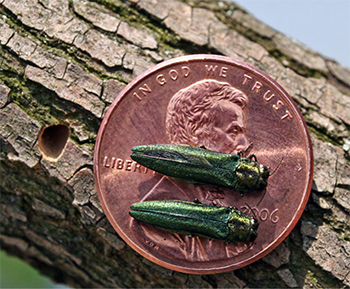Learn to identify ash trees and signs of EAB.
- Learn about ash trees and EAB, visit Oregon State University's field guide.
- Enroll in the Oregon State University's Oregon Forest Pest Detector Program

My Gresham service requests anytime, anywhere. Fix a pothole, remove graffiti, report a broken street.

Explore this peaceful oasis, just a short walk from shopping and restaurants in historic downtown.

The Emerald Ash Borer (EAB) is an invasive insect that attacks and kills ash trees.
EAB adults are metallic green with a coppery-red abdomen and about one-half inch long.
Photo from Ohio State University Extension.
To slow the spread of EAB, The Oregon Department of Agriculture issued a permanent quarantine across Multnomah, Washington, Yamhill, Marion and Clackamas Counties. Tree materials from ash, olive, and white fringe tree, must remain within quarantined counties.
For more information, visit the Oregon Department of Agriculture.
Emerald ash borer (EAB) is an invasive wood-boring beetle. EAB is responsible for the death and decline of millions of ash trees in North America. It was first detected in the Midwest and east coast in 2002.
In June, 2022, EAB was observed on the west coast. The first sighting was in Forest Grove, Oregon. In September 2025, EAB was confirmed in East Portland, a few miles from Gresham.
All ash species (Fraxinus spp.) are at risk from EAB, including the native Oregon ash (Fraxinus latifolia). This tree species is a vital part of natural areas along rivers and streams in Western Oregon. EAB changes habitats as it kills Oregon ash trees.
Non-native ash species planted as street and landscape trees are also at risk. EAB will damage ash trees in Gresham neighborhoods.
Contact the Department of Environmental Services at 503-618-2525.